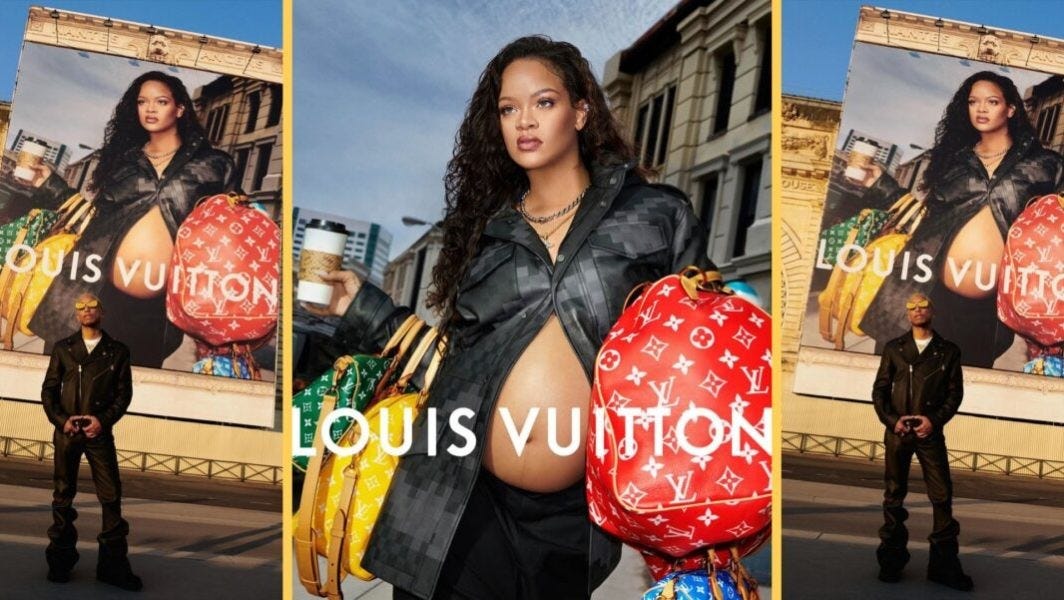Across the past year, my social media feeds have been littered with an all-too-familiar style of creative direction. Rather than meticulously staged photoshoots, we find ourselves immersed in the voyeuristic allure of lo-fi creative direction, paparazzi-style imagery showcasing celebrities in the everyday world. Celebrities like Kendall Jenner and A$AP Rocky doing paparazzi walks for the latest Bottega Veneta campaign, Lil Uzi Vert being captured on CCTV stealing a birthday cake for a Marc Jacobs campaign, Kanye West’s 3-second-pixel Superbowl selfie advert, Rihanna papped mid-errand coffee-run for Louis Vuitton - the list goes on.
This sort of art direction uses lo-fi production techniques to capture exaggerated, almost surreal facets of everyday life, with the subject being captured often a celebrity of some kind doing an average, everyday thing. Whether the photography style is more paparazzi or CCTV, the result is still the same, a sort of banal co-option of the mundane. The lo-fi capture helps these extraordinary moments, say A$AP Rocky decked out in the latest Bottega Veneta, feel more relatable to the everyday public (I too walk outside to get groceries sometimes). Even though this calibre of celebrity is so out-of-touch and unrelatable (I doubt Kendall Jenner does her own grocery shopping), it allows us to assume the role of the voyeur, to relate to the life of the celebrity.
The rise of paparazzi, IRL shots for campaigns emphasises the surrealism of everyday life, placing the viewer into the role of the voyeur, peering into the staged relatability of the celebrity. Celebrity culture has never felt more prominent, and importantly more accessible, and our parasocial relationships with the stars has been exacerbated by social media and constant exposure to content. Is there almost something humorous, letting the public in on a joke, about watching glamorous celebrities in the everyday world?
It allows us to assume the role of the voyeur, to relate to the life of the celebrity.
The roots of this phenomenon can be traced back to Surrealism, an art movement that challenged the conventions of realism and rationality. As the New York Times describes, Surrealism emerged in the 1920s as a rebellion against the status quo, giving rise to imagery characterised by disembodied eyeballs, melting clocks, and otherworldly landscapes. Fast forward to the present day, and Surrealism continues to shape our cultural landscape, providing a lens through which we can explore the absurdities of contemporary society.
For Gen-Z, often characterised as a generation disillusioned with traditional norms, Surrealism offers a means of coping with the chaos of the modern world. As Tony Wang, founder of creative consultancy Office of Applied Strategy, observes for the Business of Fashion, “There is an element of irony or self awareness that gives it that kind of edge and that charm … At the end of the day, [A$AP Rocky] is still a celebrity and he’s styled impeccably.’” The elements of irony and self awareness gives these campaigns their edge, reminding us celebrities are not immune to the surrealism of everyday life.
The rise of paparazzi-style creative direction reflects our increasingly self-referential culture, where nostalgia reigns supreme, and the boundaries between reality and fantasy are blurred. Drawing inspiration from the iconic paparazzi shots of the early 2000s, these campaigns tap into a collective longing for the raw authenticity of a bygone era. One with a chaotic ethos, where celebrity culture existed solely offline in paparazzi shots.
At the heart of this creative direction lies a desire for authenticity, a rejection of the hyper-curated world of social media in favour of something more raw and unfiltered. By eschewing traditional production techniques in favour of lo-fi aesthetics, these campaigns challenge our perceptions of what is real and what is staged, blurring the lines between fiction and reality.
Surrealism offers a means of coping with the chaos of the modern world.
The Surrealism permeating fashion and advertising offers more than just a fleeting trend; it's a reflection of our cultural zeitgeist and a testament to the power of authenticity in a world inundated with staged perfection.
When consumers crave genuine connections and immersive experiences, authenticity reigns supreme. Brands that embrace the mundane, turning everyday moments into compelling narratives, stand to captivate audiences in ways that traditional advertising cannot. By relinquishing control and embracing the imperfection of lo-fi aesthetics, they invite the viewer into a fantasy that feels surreal, yet still relatable (even if it is in a tongue and cheek way).





